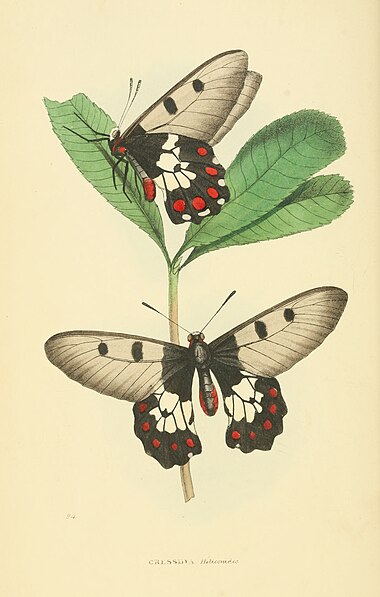CRESSIDA Heliconides
For a long time, the only museum in Europe which could boast of this butterfly, was that of Sir Joseph Banks; who found it in Van Deimans Land, during his celebrated scientific voyage with Captain Cook. Fabricius, the most eminent entomologist of that day, described the species from this specimen: which, with the whole of the Banksian Cabinet, was presented by its learned and munificent possessor to the Linnæan Society of London, where it still exists. The only published figure is that of Donovans, which is much too small, and is otherwise faulty. The species is still very rare in collections; our own, a fine pair, were received from Van Diemans Land.
CRESSIDA Heliconides
Cressida Butterfly.
Sub-Fam. Papilionæ. Genus Papilio. Sub-Genus Cressida. Nobis.
Sub-Generic Character.
Wings diaphanous; posterior perpendicularly elongated, obtusely dentated or scolloped. Antenna stout, the club very thick.
Types, Cressida Heliconides and Harmonides. Sw.
Specific Character.
Anterior wings diaphanous, with the base, and two opaque, costal transverse spots, black; posterior black, with a central white space, and a marginal row of crimson spots, brightest beneath.
Papilio Cressida, Fab. Ent. Sys. 3. 1. p. 20. Don. Ill. of Ent. 3. pl. 12. f. 2. Ency. Meth. p. 76. No. 145.
Although unacquainted with the larva, and pupa state of this species, nature has stamped the perfect insect with the image of that group she intends it to represent. Its long, narrow, anterior wings, almost transparent, immediately reminds even the unpractised entomologist of the Heliconian butterflys; while the analysis of the genus Papilio, confirms this idea, by shewing that Cressida is the Heliconian type. We scarcely need remind the student of the natural system that if our theory be correct, this representation, under one form or other, will be found to pervade every group of Lepidoptera. In all such as we have yet investigated, this opinion has been fully verified.
